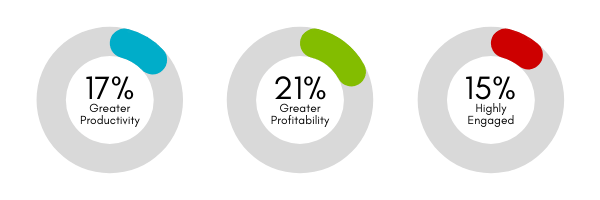The corporate world has been a bit of a minefield in the last several years. The rapidly changing landscape of the way we work and live has given rise to a litany of buzzwords, like “unprecedented”, “hybrid work”, and “new normal”. “Employee engagement” is a concept that gets thrown around a lot – but is it just another buzzword? Or is there a little bit more to it?
Employee engagement is generally described as the relationship between an organization and its employees. It involves how connected an employee feels to both the organization they belong to and their work for the organization. And it matters! The level of employee engagement at your company can directly impact both employee loyalty and employee performance. A Gallup-conducted study found that employees who feel engaged have 17% greater productivity compared with their un-engaged peers and highly engaged organizations see 21% greater profitability! Unfortunately, this same study found that in 2017, only 15% of employees could be classified as highly engaged in their jobs.
 If you are reading this blog, employee happiness and engagement is already on your mind. The real question is, how do you take employee engagement from a buzzword you toss around at your recurring Human Resource meeting to a successful employee engagement initiative that can affect real change in your organization?
If you are reading this blog, employee happiness and engagement is already on your mind. The real question is, how do you take employee engagement from a buzzword you toss around at your recurring Human Resource meeting to a successful employee engagement initiative that can affect real change in your organization?
3 Simple Steps to take Employee Engagement from Buzzword to Results
1. Build a Team
No business initiative is successful without ownership, and employee engagement isn’t any different. While you can argue that employee engagement is everyone’s responsibility, you need a team to take action. The composition of your team will depend heavily on your company’s size, makeup, and the current status of your company culture. According to Hannah Price at Jostle, it needs to be comprised of two main groups- Leaders and Ambassadors
- Leaders – Anytime you start a new initiative, you need to start at the top. This group should ABSOLUTELY include your CEO and other C-Suite members. Depending on your organization, it can also include managers and other “unofficial” leaders who can model desired behaviors and actively participate in any employee engagement measures your company takes. This group should strive to integrate employee engagement solutions into your company vision.
- Ambassadors – Ambassadors can help engagement initiatives by bringing ideas to the table, researching, and doing the administrative work necessary to launch your plan. They are the supporters, promote the initiatives, and consistently display genuine care for their teammates and company core values. This group will vary in size and should include various people and departments. If you want your endeavour to be successful, diversity is critical.
2. Make a Plan
You’ve built your team – now what? Your next step is to build out a plan to measure both a baseline of how engaged your employees are and how you will measure and recognize your progress.
Measuring engagement is essential in discovering where your strengths lie, uncovering hidden truths in your organization and building trust with your employees. Showing your team that you care about the employee experience is often the first step. Measuring engagement can include implementing an annual engagement survey or a pulse survey, doing exit interviews with departing team members, using Employee Net Promoter Scores (through an eNPS surveyor), analyzing your employee retention and absentee rates (Highly engaged workplaces saw 41% lower absenteeism) and providing other ways for employees to provide honest feedback. One thing to keep in mind here is to use a combination of strategies to reach all your employees, not just a random sampling. Source
3. Take Action
Finally – put your plans into action! Now is the time to take your initiative to the streets and “pound the pavement”. After you have identified your strengths and weaknesses as an organization, you might want to implement employee engagement software tools that specialize in the employee experience, such as TINYPulse or Culture Amp. (Check out my other blog to see how SPLICE utilizes TINYPulse to improve our company culture)
As you collect data, ensure that you use it to affect change (not just amassing information). Take steps to provide opportunities for growth, while recognizing and rewarding employees in a variety of ways. This can be both effective in improving how engaged employees are and how loyal employees feel towards their company. You can also take steps to improve your employee engagement before you even hire employees. Ask questions during your recruitment process that can help reveal a person’s character and values, then hire highly engaged people, not just highly skilled people.
Improving employee engagement within your organization cannot be done in a day (or even a month!) but acknowledging that it is not just another buzzword is the first step. Employees can make or break a company, so taking steps to implement a long-term and ongoing employee engagement program to fully support the entire employee lifecycle is worth both the time and the effort.
